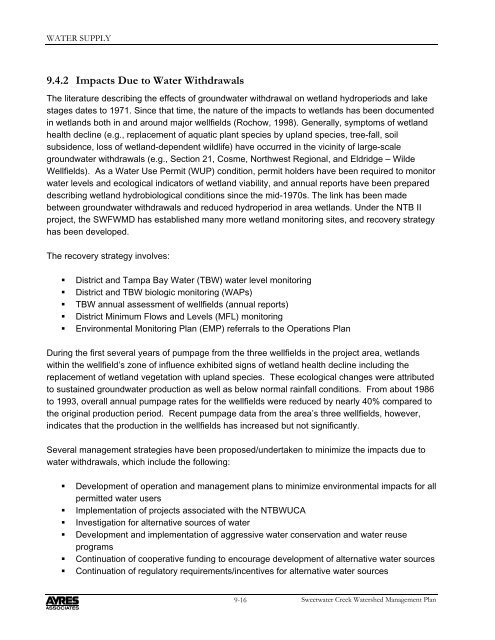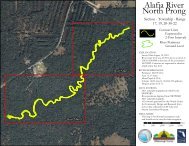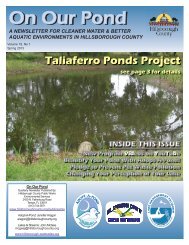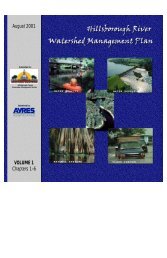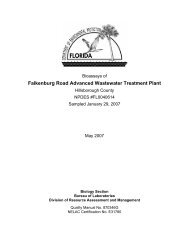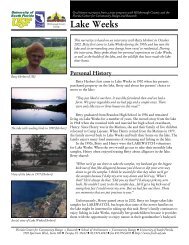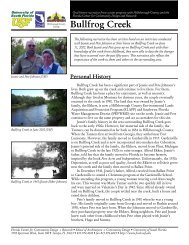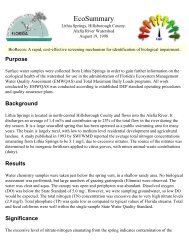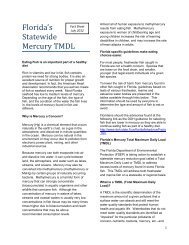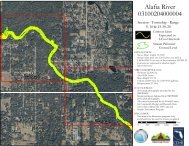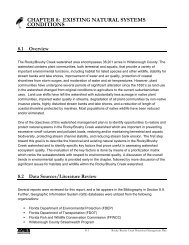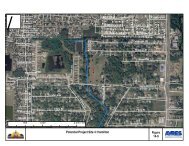Sweetwater Creek Watershed Mgmt. Plan 2007 Update--Part 2
Sweetwater Creek Watershed Mgmt. Plan 2007 Update--Part 2
Sweetwater Creek Watershed Mgmt. Plan 2007 Update--Part 2
Create successful ePaper yourself
Turn your PDF publications into a flip-book with our unique Google optimized e-Paper software.
WATER SUPPLY<br />
9.4.2 Impacts Due to Water Withdrawals<br />
The literature describing the effects of groundwater withdrawal on wetland hydroperiods and lake<br />
stages dates to 1971. Since that time, the nature of the impacts to wetlands has been documented<br />
in wetlands both in and around major wellfields (Rochow, 1998). Generally, symptoms of wetland<br />
health decline (e.g., replacement of aquatic plant species by upland species, tree-fall, soil<br />
subsidence, loss of wetland-dependent wildlife) have occurred in the vicinity of large-scale<br />
groundwater withdrawals (e.g., Section 21, Cosme, Northwest Regional, and Eldridge – Wilde<br />
Wellfields). As a Water Use Permit (WUP) condition, permit holders have been required to monitor<br />
water levels and ecological indicators of wetland viability, and annual reports have been prepared<br />
describing wetland hydrobiological conditions since the mid-1970s. The link has been made<br />
between groundwater withdrawals and reduced hydroperiod in area wetlands. Under the NTB II<br />
project, the SWFWMD has established many more wetland monitoring sites, and recovery strategy<br />
has been developed.<br />
The recovery strategy involves:<br />
• District and Tampa Bay Water (TBW) water level monitoring<br />
• District and TBW biologic monitoring (WAPs)<br />
• TBW annual assessment of wellfields (annual reports)<br />
• District Minimum Flows and Levels (MFL) monitoring<br />
• Environmental Monitoring <strong>Plan</strong> (EMP) referrals to the Operations <strong>Plan</strong><br />
During the first several years of pumpage from the three wellfields in the project area, wetlands<br />
within the wellfield’s zone of influence exhibited signs of wetland health decline including the<br />
replacement of wetland vegetation with upland species. These ecological changes were attributed<br />
to sustained groundwater production as well as below normal rainfall conditions. From about 1986<br />
to 1993, overall annual pumpage rates for the wellfields were reduced by nearly 40% compared to<br />
the original production period. Recent pumpage data from the area’s three wellfields, however,<br />
indicates that the production in the wellfields has increased but not significantly.<br />
Several management strategies have been proposed/undertaken to minimize the impacts due to<br />
water withdrawals, which include the following:<br />
• Development of operation and management plans to minimize environmental impacts for all<br />
permitted water users<br />
• Implementation of projects associated with the NTBWUCA<br />
• Investigation for alternative sources of water<br />
• Development and implementation of aggressive water conservation and water reuse<br />
programs<br />
• Continuation of cooperative funding to encourage development of alternative water sources<br />
• Continuation of regulatory requirements/incentives for alternative water sources<br />
9-16<br />
<strong>Sweetwater</strong> <strong>Creek</strong> <strong>Watershed</strong> Management <strong>Plan</strong>


